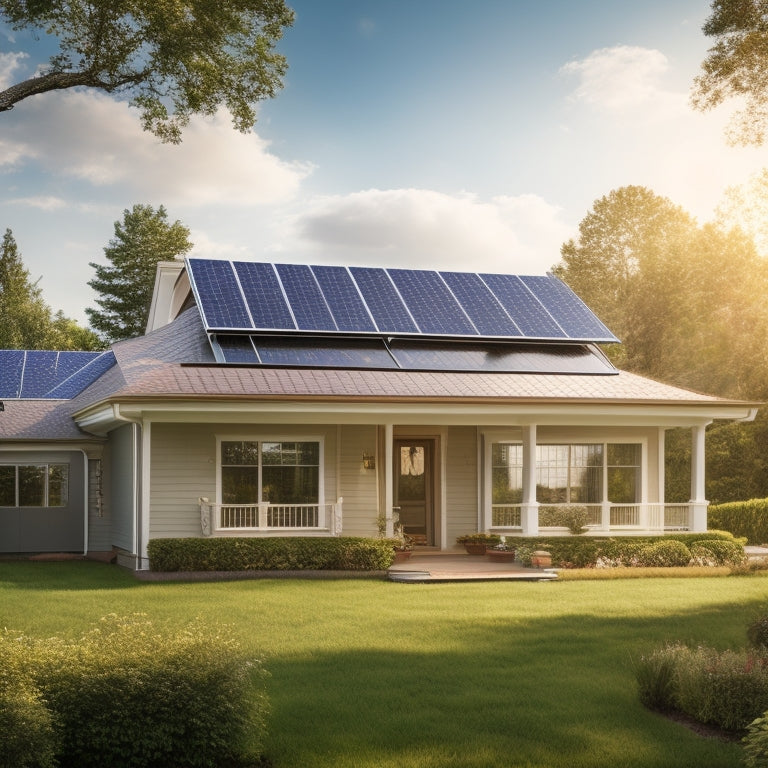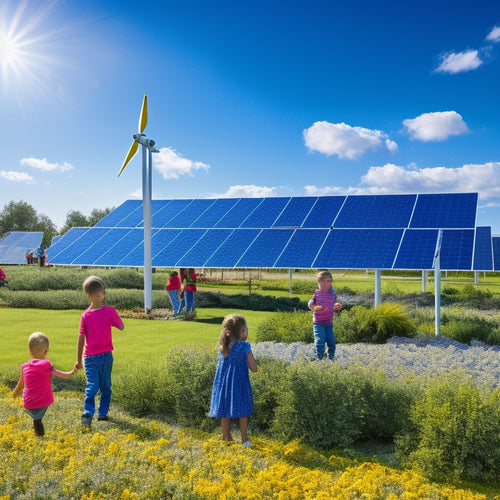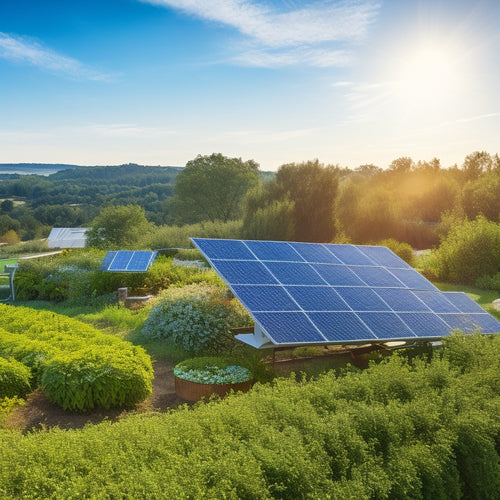
What Expenses Should You Consider for Solar Panels on Your House
Share
When contemplating solar panels for your house, you'll need to factor in a range of expenses beyond the initial installation cost. You'll need to think about the type and cost of solar panels, inverters, and mounting hardware, as well as roof assessments and potential repairs. Permits and inspection fees can add up quickly, and energy storage systems can be a significant additional expense. Ongoing costs like inverter replacement, maintenance, and repair fees, as well as monitoring and tracking expenses, should also be factored into your budget. As you weigh the costs and benefits, you'll want to take into account all these factors to get a complete overview.
Key Takeaways
- Initial installation costs range from $15,000 to $30,000, but financing options and tax incentives can significantly reduce expenses.
- Equipment and hardware expenses vary by type and quality, including solar panels, inverters, mounting hardware, and monitoring systems.
- Roof condition assessment and potential repairs, as well as permits and inspection fees, must be factored into the overall cost.
- Energy storage system costs, including battery and installation expenses, can range from $7,000 to $20,000 or more.
- Ongoing expenses, such as maintenance, repair, and monitoring fees, should be budgeted for to ensure optimal system performance and longevity.
Initial Installation Costs
Your initial investment in solar panels lies in the upfront installation costs, which can vary widely depending on your location, system size, and equipment choices.
These costs can range from $15,000 to $30,000 or more for a typical residential system. However, you can reduce this burden by exploring financing options. Many solar panel providers offer financing plans with little to no down payment, making it more accessible to homeowners.
Moreover, you can benefit from tax incentives, such as the Solar Investment Tax Credit (ITC), which allows you to claim a percentage of the total installation cost as a credit on your federal taxes.
This can greatly reduce your overall expenses. In addition, some states and utilities offer additional rebates and incentives, which can further lower your upfront costs.
Equipment and Hardware Expenses
Install solar panels and you'll need to evaluate the cost of equipment and hardware, a significant component of your overall expenses. This includes the solar panels themselves, which vary in cost depending on their type and energy efficiency.
Monocrystalline silicon panels, for instance, are more expensive than polycrystalline silicon panels but offer higher energy efficiency. Thin-film panels, on the other hand, are less expensive but also less efficient.
You'll also need to factor in the cost of inverters, which convert DC power from the solar panels into AC power for your home. The type and quality of inverter you choose will impact the overall performance and cost of your system.
Additionally, you'll need to take into account the cost of mounting hardware, such as rails and clamps, as well as wiring and connectors. Other equipment expenses may include a monitoring system to track your energy production and consumption, and a battery backup system for energy storage.
Be sure to research and compare prices for each component to guarantee you're getting the best value for your money.
Roof Repair and Replacement
When considering solar panel installation, you'll need to assess your roof's condition to determine if repairs or replacement are necessary.
This assessment will help identify any structural weaknesses that may require reinforcement to support the added weight of the solar panels.
Roof Condition Assessment
Before mounting solar panels, evaluating the condition of your roof is essential to confirm a safe and efficient installation. You need to determine if your roof can support the weight of the solar panels and ascertain they're compatible with your roof material. This assessment will help you identify any potential issues that could affect solar panel longevity.
As you inspect your roof, look for signs of wear, such as cracked, curled, or missing shingles, and check for damaged or rotten wood. You should also verify that your roof is structurally sound and can handle the added weight of the solar panels.
Additionally, consider the roof material compatibility with the solar panels' mounting system. For instance, asphalt shingles may require a specific type of mounting clip, while metal roofs may need a specialized fastening system.
A thorough roof condition assessment will help you address any necessary repairs or replacements before installing your solar panels, confirming a secure and efficient installation that will maximize your energy production.
Roof Structural Reinforcement
Through a thorough roof condition assessment, you've identified potential issues that need addressing prior to solar panel installation.
Now, it's vital to determine if your roof requires structural reinforcement to support the added weight of solar panels. A load capacity evaluation will help you understand if your roof can handle the additional load of the solar panels, mounting hardware, and other equipment.
Based on the evaluation, you may need to explore reinforcement options to guarantee your roof can safely support the solar panel system. This might involve repairing or replacing damaged or weakened roof structures, such as rafters, trusses, or roof decking.
You may also need to add additional support beams or upgrade your roof's framing to increase its load capacity.
The cost of roof structural reinforcement will vary depending on the extent of the work required.
However, it's important to prioritize this step to secure a safe and secure solar panel installation. A reinforced roof will provide a solid foundation for your solar panel system, allowing you to generate clean energy for years to come.
Permits and Inspection Fees
You'll need to secure various permits and undergo inspections to confirm your solar panel installation meets local building codes and safety standards. This process can be complex, so it's crucial to understand the requirements and fees associated with it.
The permit application process typically involves submitting your solar panel installation plans to your local government, which will review them to verify compliance with building codes and regulations.
You'll need to pay a fee for the permit application, which can range from $500 to $2,000, depending on your location and the complexity of the project.
Additionally, you'll need to satisfy inspection requirements, which may involve multiple visits from local building inspectors to verify that the installation meets safety standards.
Inspection fees can add up quickly, with costs ranging from $100 to $500 per visit. Be sure to factor these expenses into your overall budget to avoid surprises down the line.
Energy Storage System Costs
In tandem with your solar panel installation, an energy storage system (ESS) can greatly enhance your ability to capture and employ renewable energy.
An ESS allows you to store excess energy generated during the day for use during the night or on cloudy days, increasing your energy independence.
When considering an ESS, you'll need to factor in the following costs:
- Battery Cost: The cost of the battery itself, which can range from $5,000 to $15,000 or more, depending on the type and size of the battery.
Keep in mind that a longer battery lifespan means fewer replacements over the system's lifetime, resulting in lower overall costs.
-
Installation Cost: The cost of installing the ESS, including labor and materials, which can range from $2,000 to $5,000.
-
Energy Efficiency: The efficiency of the ESS in converting DC power from your solar panels to AC power for your home, which can affect the overall energy output.
-
Monitoring and Maintenance: The cost of monitoring the ESS and performing routine maintenance to guarantee peak performance and extend the battery lifespan.
Inverter Replacement Costs
You'll need to factor in inverter replacement costs when calculating the total expenses for your solar panel system, as these components typically have a shorter lifespan than the panels themselves.
On average, you can expect your inverter to last around 10 to 15 years, depending on the quality of the unit and environmental factors.
When it's time to replace your inverter, you can expect to pay anywhere from $1,000 to $3,000 or more, depending on the type and size of the new unit.
Inverter Lifespan Expectations
About every 10 to 15 years, your solar panel system's inverter will likely need replacing, as it's only designed to last that long. This lifespan is a result of the inverter's internal components degrading over time, reducing its efficiency and overall performance.
You should be aware of the following factors that affect your inverter's lifespan:
-
Inverter technology advancements: Newer inverters are designed with improved components, leading to increased efficiency and longer lifetimes.
-
Inverter efficiency ratings: Higher-rated inverters tend to last longer than lower-rated ones, as they produce more power per unit of input.
-
Operating temperatures: Extreme temperatures can reduce your inverter's lifespan, so it's vital to guarantee proper ventilation and cooling.
- Maintenance and monitoring: Regular maintenance and monitoring can help identify potential issues before they become major problems, extending your inverter's lifespan.
Replacement Cost Estimates
Replacing your solar panel system's inverter can be a considerable expense, with costs ranging from $2,000 to $5,000 or more, depending on the type and quality of the replacement inverter.
You'll need to factor in the replacement value when budgeting for your solar panel system's maintenance. It's important to understand that inverters typically last between 10 to 15 years, and their failure can greatly impact your system's energy production.
When calculating the replacement cost, consider the type of inverter you need. A high-quality inverter with advanced features, such as monitoring and tracking capabilities, will likely be more expensive than a basic model.
Additionally, the installation cost, which can range from $1,000 to $2,000, should be included in your estimate.
While the upfront cost may seem overwhelming, remember that a new inverter can help you achieve long-term savings by ensuring your system operates at maximum efficiency.
Maintenance and Repair Fees
Most solar panel systems require minimal maintenance, but occasional repairs and part replacements are still necessary to secure peak performance and longevity.
As a homeowner, you should budget for these expenses to guarantee your system operates efficiently and effectively.
You'll need to take into account the following maintenance and repair fees:
-
Warranty coverage: Check your warranty terms to see what's covered and for how long. Some manufacturers offer extended warranty options for an additional fee.
-
Cleaning services: Regular cleaning can improve your system's efficiency. You can either clean the panels yourself or hire a professional service, which may cost around $100 to $300 per year.
-
Inverter replacement: Inverters typically need to be replaced every 10 to 15 years, with costs ranging from $1,000 to $3,000.
- Electrical component repairs: Faulty electrical components, such as circuit breakers or fuses, may need to be replaced, with costs varying depending on the type and complexity of the repair.
These expenses are essential to maintaining your solar panel system's performance and longevity.
Be sure to factor them into your overall budget to avoid unexpected costs down the line.
Monitoring and Tracking Expenses
One essential aspect of ensuring your solar panel system operates at its best is monitoring and tracking its performance. This involves investing in monitoring tools and tracking software that provide real-time data on your system's energy production, voltage, and temperature.
With this information, you can identify potential issues before they become major problems, maximizing your system's efficiency and reducing downtime.
You'll likely need to pay a subscription fee for these monitoring services, which can range from $50 to $200 per year, depending on the provider and the level of detail you require. Some popular options include Enphase, Sense, and Tesla's monitoring platform.
These tools can also help you optimize your energy usage, providing information into your consumption patterns and suggesting ways to reduce your reliance on the grid.
When budgeting for monitoring and tracking expenses, consider the cost of the initial setup, as well as ongoing subscription fees. Additionally, factor in the potential savings from increased efficiency and reduced maintenance costs.
Frequently Asked Questions
Can I Install Solar Panels on a Rented Property?
You'll need to get your landlord's permission before installing solar panels on a rented property, as it's a significant alteration; consider drafting an agreement that outlines responsibilities, maintenance, and potential benefits sharing during the solar panel installation process.
Do Solar Panels Increase My Property Taxes?
When you install solar panels, you're likely to see an increase in your property value, which may lead to higher property taxes. However, you'll also benefit from tax incentives that can help offset these increased costs, making solar energy a smart investment for you.
Will Solar Panels Affect My Homeowner's Insurance?
As you utilize the sun's energy, consider how solar panels will impact your homeowner's insurance: like a safety net, your policy may adjust premiums to reflect added value, and routine solar panel maintenance can mitigate potential risks, ensuring your investment shines bright.
Can I Sell Excess Energy Back to the Grid?
You can sell excess energy back to the grid through net metering, earning energy credits that offset your consumption during periods of low solar production, allowing you to maximize your solar investment and reduce your reliance on traditional power sources.
Are Solar Panels Covered by a Warranty?
When you invest in solar panels, you'll typically get a warranty covering parts and labor for 25 years, with some manufacturers offering extended warranty durations. You'll also need to factor in maintenance costs, which can be minimal if you perform routine checks and cleaning.
Conclusion
You've made it to the final stretch! Now that you've considered all the expenses involved in installing solar panels on your house, you're ready to make an informed decision. Curiously, did you know that a typical solar panel system can save homeowners between $400 and $1,000 per year on their electricity bills? With the right planning and budgeting, you can utilize the power of solar energy to reduce your carbon footprint and enhance your savings.
Related Posts
-

Solar Power for Community Energy Independence
Solar power is essential for your community's energy independence, offering both environmental and economic benefits....
-

Solar Power Advantages for Rural Communities
Solar power presents numerous advantages for rural communities. You can greatly reduce energy costs, potentially by u...
-

Green Energy Alternatives for Independent Living
To enhance your independent living, consider green energy alternatives like solar panels and wind turbines. These opt...


